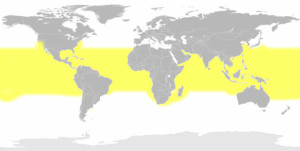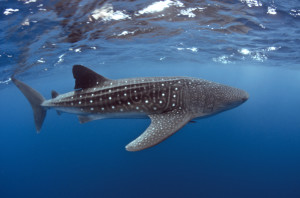Whale Shark Territory:
Whale Shark Basic Facts:
Diet: Carnivore
Size: 18-33ft (5.5-10 m)
Weight: 20 tons (40,000lbs or 20,0000Kgs)
Life Span: 60 to 100 Years
Group Name: School or shoal
Whale Shark Photos:
Photography from iStockPhoto
Despite their size, whale sharks are known to be very gentle and safe to humans. They only feed on planktons and small fish. The whale shark has a very huge head and a mouth that is 6.5ft (2m) wide. They feed by swimming with their mouths wide open. They trap plankton, squid, krill, and other small fish in their gills as the in-flowing water exits (filter feeding). They are seasonal feeders tending to swim and feed in groups. It is common to find as many as 400 whale sharks feeding together.
Whale sharks rarely swim alone, which is unusual compared to most sharks. Whale Sharks are normally in the company of a whole school of smaller fish, or human divers “catching a ride.” The whale sharks inhabit all the warm tropical seas and oceans, from South Africa to the Tanzanian Islands of Pemba and Mafia, all the way to Western Australia. They travel throughout the world, running away from the cold weather.
They attain sexual maturity at the age of 30 years and live to between 60-100 years. They grow to a length of 40ft (12m) and weigh 20 tons (40,000lbs or 20,0000Kgs). At that length and weight, the Whale Shark is the largest fish on earth. The whale shark has grey-like skin and a white under-belly. The unique distinguishing physical characteristic is pale yellow and whitish spots on the upper body. These spots are unique to each whale shark, just like fingerprints in humans. They have two pairs of fins, dorsal and pectoral.
It is interesting to note that no man has witnessed the whale sharks mating or giving birth (pupping). Their eggs mature inside the body of the female whale shark (oviparous reproduction method). Unlike most fish, which hatch their eggs outside for the male to fertilize (viviparous). The Whale Shark gives birth to live young ones, called pups, about 2ft (60cm) in size. A single female whale shark can carry up to 300 eggs. Not all fertilized mature into pups, some actually feed on other eggs.
Whale Sharks have been kept in captivity at three aquariums in Japan proving to be great tourist attraction. The Osaka Aquarium Kaiyuk has two Whale Sharks, the Okinawa Churaumi Aquarium had three as of 2005, and Kagishim Aquarium one adult. Two male and two female Whale Sharks also live in captivity in Atlanta, USA at the Georgia Aquarium.


